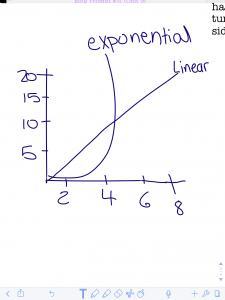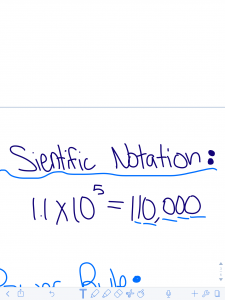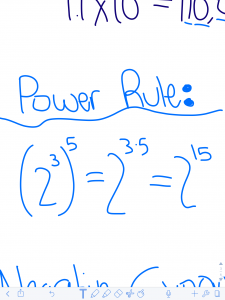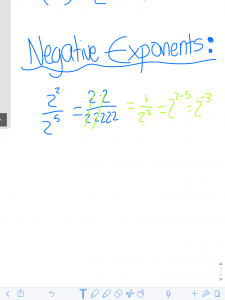Linear V.S. Exponential Growth
The differences between linear and exponential growth is that linear growth increases at a constant non-changing rate, while the exponential growth’s rate changes each time. In a table, linear growth is normal where it grows constantly by a certain number but exponential grows by an exponent. Exponential grows each time by multiplying the Y- values by a number each time. In a graph linear will make a normal line out of the points, while exponential growth graphs make a curve. Linear expressions are normal y=mx + b, while exponential expressions multiply 2 numbers with one having an “x” exponent to get Y. The linear equation grows each time by multiplying a certain number by the x-values plus the (0,y) point. The exponential equation grows by the y-values being multiplied by a certain number each time.
Scientific Notation
Scientific notation is the way that scientists or people can write large numbers or small numbers. In scientific notation when there is a exponent it means that is the amount of times the decimal gets moved to the right. When there is a exponent with a dash it means that is how many times the decimal will get moved to the left. For example, 3.25×10(5) would equal 325,000. Then 4×10(-6) would equal 0.000004. The difference between 3(8) and 3×10(8) is that 3(8) is being multiplied by 3 eight times where as 3×10(8) is adding 8 zeros before the decimal. So 3(8) would equal 59,049 and 3×10(8) would equal 300,000,000.
Simplifying Exponent Expressions Using the Product and Quotient Rules
We have been learning about ways to rewrite and simplify exponent expressions involving multiplication and division with the power, product, distributive product, distributive quotient, quotient, and the zero exponent rule. The power rule lets us simplify the amounts of exponents. For example to simplify 2(2)3 it would create 3 groups of 2(2) and then we’d count the 2’s and all together there’d be 2(6). The product rule breaks down and add exponents like this, 2(2) 2(3) = 2•2•2•2•2 = 2(5). The distributive rule for products is the same as the product rule except now it is adding 2 numbers with exponents by (2•3)3 = (2•3)•(2•3)•(2•3)= 2•2•2•3•3•3= 2(3)3(3). The quotient rule subtracts exponents. Example : 2(3)/2(2) = 2•2•2/2•2 = 2/1 = 2(1). Next the distributive rule, this one adds exponent numbers by how the exponential number. Example : (2/3)4 = (2/3) (2/3) (2/3) (2/3) = 2(4)/3(4). Lastly the zero exponent rule also subtracts the exponents. Example : 2(3)/2(3) = 2•2•2/2•2•2 1/1 = 1 = 2(3-3) = 2(0).
NEgative Exponents
When an exponent is negative it isn’t really negative it is just a positive number or variable becoming smaller. When subtracting the extra exponents, they become fractions. They also become the reciprocal of each other because when it has a negative exponent on one side then it will turn the exponent positive and be on the opposite side. For example a (-n) = 1/a(n).








Leave a Reply